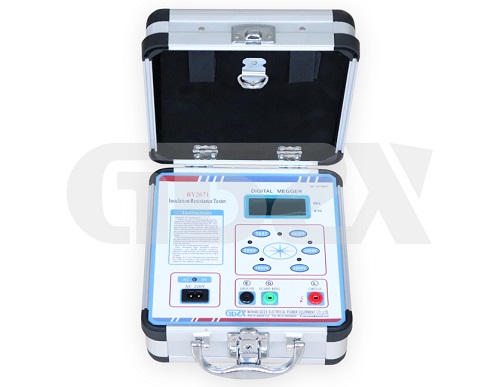NEWSnews
What Are The Test Types of Insulation Resistance?
Insulation resistance is the basic insulation index of electrical equipment and electrical lines. Therefore, the test object of the insulation resistance test is a device such as conductors and electrical parts to determine the insulation status of the equipment, check whether there is a defect in the insulation of the electrical equipment, and avoid electrical accidents caused by insulation defects. There are the following types of insulation testing: design testing, production testing, handover acceptance testing, preventive maintenance testing, and fault location testing. Different test types depend on different test purposes and application areas, and different insulation test processes also have different characteristics. GDZX arranges the following test types.
1. Design test
Design tests are generally used to determine the performance of electrical devices in the laboratory. Design testing is usually performed by the manufacturer on newly designed devices or devices purchased from other companies and used in product design. The design test checks whether the device is faulty. Insulation resistance test is required before manufacturing any product.
When testing insulation, apply high voltage to each device until the insulation of the device fails, resulting in a leakage current higher than the acceptable current. Not only design testing is required when designing the product for the first time, but as long as the product is modified, testing is required. For different devices, according to their different working voltages, working conditions and performance requirements, they need to be tested with different voltages to measure, which requires that the test instrument should have different test voltages.
2. Production test
In order to ensure that products that work properly in the laboratory still work properly after production, each product must be tested for production. Production testing is carried out by the manufacturer to meet the requirements of specifications and standards and to ensure quality control. Before new products and equipment are put into use, perform insulation resistance tests. In production testing, product defects are usually revealed. Production testing is usually non-destructive. Because the performance of the components to be installed on the production line must be tested to meet the insulation requirements. Since the purpose of this test is only to verify whether the components have sufficient insulation strength, rather than the factory acceptance test of the overall equipment, no specific parameters are required, but only the qualification is required.
3. Handover acceptance test
The acceptance test is performed by the installer after completing the installation, but before the system is put into use. The acceptance test includes insulation resistance test to check whether there is equipment damage, cable damage, whether the spacing between electrical components is appropriate and firm, and whether storage, transportation and installation cause damage to the product.
Then, in the field installation acceptance test, the insulation resistance, absorption ratio (hereinafter referred to as DAR) or absorption ratio (hereinafter referred to as PI) must be measured. Since the on-site environment is usually harsh, it is very important for users to make the on-site measurement more convenient and simple.
4. Preventive testing
Many factories include testing insulation resistance and conductors of equipment as part of their overall preventive maintenance procedures. The condition of the wire insulation is a good indicator of the overall condition of the equipment and electrical system. Good preventive maintenance procedures can detect and eliminate failures before they cause downtime.
The failed insulation must be repaired to ensure that the system will not fail at an inappropriate time. Generally speaking, after all systems work for a long time, the quality of the insulation layer of its wires will degrade at a predictable rate. By regularly measuring the insulation resistance, you can avoid wire insulation failure (or life expectancy).
5. Insulation test to eliminate fault
Even if the manufactured equipment is of high specifications, properly installed, with correct specifications, and undergoes preventive maintenance testing, fault location testing is still required because the equipment will still fail. Faults are usually caused by fragile or damaged parts in a faulty circuit. When a device, equipment, circuit or system fails, the insulation resistance test is used to locate the fault. Using insulation resistance testing to troubleshoot requires knowledge of equipment, circuits, and test equipment.
6. Routine maintenance
Generally, all electrical equipment needs daily maintenance. The purpose of maintenance is to find out the potential faults or minor faults. If these hidden dangers or minor faults are found earlier, they can be eliminated after no loss (shutdown, equipment damage or personal injury) or very small loss. Routine maintenance can be divided into regular maintenance and unscheduled maintenance, or preventive maintenance and predictive maintenance according to the purpose of maintenance test.
Regular routine maintenance experiments work at specific intervals to prevent downtime and inefficiency, and determine plans based on time, such as: every day, every week, every month, every quarter, or several hours for equipment. Tasks include equipment inspection, regular inspection of lubricating oil, adjustment of equipment and replacement of parts, inspection of electrical, hydraulic and mechanical systems of operating equipment. Maintain one or more equipment on a regular basis throughout the year. The random maintenance carried out by maintenance personnel includes emergency work and shutdown maintenance.
Preventive maintenance is to keep the peak working condition of the equipment, which combines regular maintenance with irregular maintenance. Predictive maintenance is to monitor the wear condition and equipment characteristics according to the predetermined tolerance, and predict the possible faults. The requirements of routine maintenance test and handover acceptance test are very close.
In the insulation resistance test, the insulation resistance tester can be used to test the insulation resistance of electrical equipment, which is a simple auxiliary method to check the insulation state of electrical equipment. In order to avoid accidents to a large extent, GDZX suggests taking preventive measures.





















